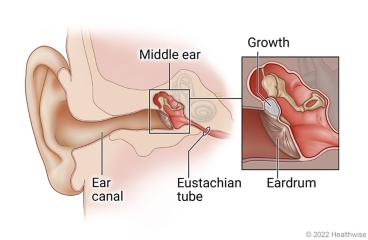
Overview
A cholesteatoma is a growth (cyst) inside the ear. The most common cause is a problem with the eustachian tube. Once the growth starts, it can keep growing and cause ear infections. Your child may feel pain and pressure in or near one or both ears. Your child also may have bad-smelling fluid that drains from the ear. Your child may lose hearing in that ear. Hearing may come back after the growth is removed.
Your child's doctor may do tests to find out the size and shape of the growth. The doctor may clean your child's ear and prescribe antibiotics if there is an infection. In most cases, children have surgery to remove the growth. After surgery, your child will need follow-up care to be sure the growth and infections don't come back.
Follow-up care is a key part of your child's treatment and safety. Be sure to make and go to all appointments, and call your doctor if your child is having problems. It's also a good idea to know your child's test results and keep a list of the medicines your child takes.
How can you care for your child at home?
- If the doctor prescribed antibiotics for your child, give them as directed. Do not stop using them just because your child feels better. Your child needs to take the full course of antibiotics.
- Give your child acetaminophen (Tylenol) or ibuprofen (Advil, Motrin) for pain. Read and follow all instructions on the label. Do not give aspirin to anyone younger than 20. It has been linked to Reye syndrome, a serious illness.
- Do not give your child two or more pain medicines at the same time unless the doctor told you to. Many pain medicines have acetaminophen, which is Tylenol. Too much acetaminophen (Tylenol) can be harmful.
- Apply heat to the ear to ease pain. Use a warm washcloth. Be careful not to burn the skin around the ear. Your child's ear may have some drainage.
- If you are going to have the growth removed, your doctor will give you instructions for your child's care before and after surgery.
- Do not put anything into your child's ear canal. For example, do not use a cotton swab to clean the inside of your child's ear. It can damage the inner ear. If you think that your child has something inside the ear, ask your doctor to check it.
When should you call for help?
Call your doctor now or seek immediate medical care if:
- Your child's pain gets worse.
- Your child has signs of infection, such as:
- Increased pain, swelling, warmth, or redness.
- Pus draining from the ear.
- A fever.
- The side of your child's face seems to sag.
Watch closely for changes in your child's health, and be sure to contact your doctor if:
- Your child feels dizzy.
- Your child does not get better as expected.
Where can you learn more?
Go to http://www.healthwise.net/patientEd
Enter B324 in the search box to learn more about "Cholesteatoma in Children: Care Instructions".
Current as of: October 27, 2024
Author: Ignite Healthwise, LLC Staff
Clinical Review Board
All Ignite Healthwise, LLC education is reviewed by a team that includes physicians, nurses, advanced practitioners, registered dieticians, and other healthcare professionals.

